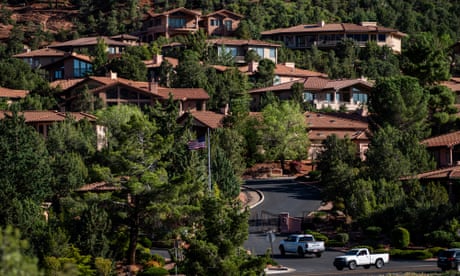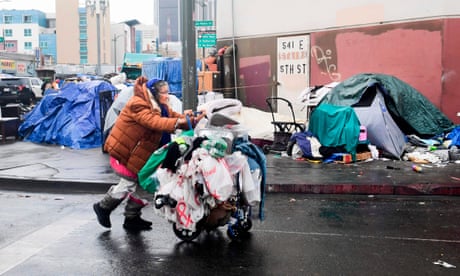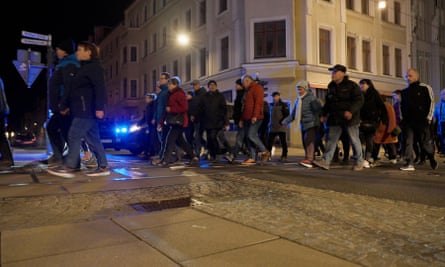Housing costs and homelessness are on the rise in California. In the Austrian capital, people of all income levels live in subsidised housing – and more is being built
THAT'S SOCIALISM
Kirsty Lang in Vienna
Tue 30 Apr 2024
THE GUARDIAN
Imagine a beautiful city where a centrally located two-bedroom apartment can cost you as little as $600 a month. For many US policymakers, it’s a pipe dream. And yet in Vienna, it’s a reality.
In the past two years, at least four delegations of housing experts and political leaders from California have visited the Austrian capital, hoping to unlock the secrets of why Vienna regularly comes top in surveys of the world’s most livable cities.

‘We just need a little help’: how a safe parking plan for people living in cars split a US town
They’re struck by the absence of homeless encampments, and marvel at the sheer scale of the subsidised housing developments which include shared amenities such swimming pools, gyms, workshops, communal gardens and spacious roof terraces.
And they wonder how they can bring some of it home to a region gripped by an unaffordability crisis that lands long-term residents out of state or on the streets.
Last year, California counted more than 180,000 people living on the streets, a 40% rise in five years. Housing costs in the state are now double what they are in the rest of the US. Average monthly payments for a newly purchased mid-tier home are more than $5,500 a month and wages have not kept pace with rising rents. “You now need to earn $200,000 a year to have a comfortable middle-class life in California,” said Jennifer LeSar of the Global Policy Leadership Academy, which organises the trips to Vienna.
The foundation of Vienna’s success is a housing policy that ensures all people live in dignified circumstances at affordable rents in homes they can keep for their lifetime and even pass on to their children. It’s not just for the poorest but the middle class as well. Sixty per cent of people in Vienna live in subsidised housing, compared with just 5% of Californians.
“This is incredible. The US sucks man. Why can’t we do this?” said Ruben Mendoza, a young activist from Uplift San Bernardino, shaking his head in disbelief as he was shown around a mixed housing development near the city centre with communal facilities and affordable rents. Mendoza said one of the reasons he became a housing advocate was because he feared never being able to own a home in the community he grew up in. Like most Californians, he spends more than 50% of his disposable household income on rent. In Vienna, residents on average spend 27% of their income on housing.
There are some obvious differences. Vienna is densely built, with the majority of residents living in relatively small apartments within easy distance of the city centre. Most Viennese are renters, and use the well-connected public transport system to move around. Most Californians live in owner-occupied single-family homes in the suburbs. Public transportation systems are underfunded, and most residents use their car to travel.
Unfortunately, in my city, some people think finding room for cars is more important than building homes for peopleGleam Davis, a Santa Monica councilmember
But the biggest difference is how much new affordable housing is going up in Vienna. “Just look at all the cranes,” said Adam Briones from California’s Community Builders, a research and advocacy organization working to close the racial wealth gap through housing. The city of Vienna builds about 6,000-7,000 new units of subsidised housing every year as it tries to keep up with rising demand. “They’re just building more housing than us. It’s not rocket science,” said Corey Smith of San Francisco’s Housing Action Coalition.
Vienna is the fastest-growing capital in Europe. Half of its residents were either born outside Austria or have parents who were, so city planners are constantly anticipating future demand. Until the 1990s, this once grand imperial capital was in the doldrums, stuck out on the edge of western Europe. It was once the centre of the Habsburg empire and the cultural and intellectual capital of Europe. Two world wars, fascism and the brutal destruction of the city’s once-vibrant Jewish population put an end to that. The artists and the intellectuals had left. It was an ageing city, full of ghosts and the remnants of a fallen empire.
Two historic shifts at the end of the last millennium changed Vienna’s fortunes. Communism collapsed in 1989, the iron curtain came down and Austria joined the European Union six years after that. Young people from across central and southern Europe moved to Vienna, attracted by the wide availability of housing, its relative affordability, job opportunities and its position at the centre of a new enlarged European Union. Since then, its population has grown by 25%. Today 2 million people live there, and their number is growing year on year.
Nimbyism was a recurring topic during the week-long visit, with the Californians complaining that often when new developments are planned, small groups of residents try to block them through the courts, which makes the construction process slower and more expensive. Gleam Davis, a Santa Monica city councillor and former mayor, said that when her city tried to build affordable housing on parking lots, residents protested. “Unfortunately, in my city, some people think finding room for cars is more important than building homes for people.” Even within her own city council, there is strong opposition to building more housing, she said. “Some of my colleagues think we can police ourselves out of this or build our share of affordable housing in the desert and move those people out there.”
Vienna has a more top-down approach to tackling nimbyism. As the delegation toured Seestadt Aspern, a new town built on a former military airfield outside Vienna, the urban planner Kurt Hoftstetter explained that they had held up to 20 meetings in the nearby villages before they began construction. “We did this to inform residents of our plans and ask them how we could make it more acceptable to them. But we did not ask their permission.”

Tech billionaires want to build a new city in rural California. Voters may get a say on it
Vienna’s affordable housing system is supported by a 1% tax on all salaries which provides a permanent funding stream for new construction. This goes back 100 years to the end of the first world war, when the city was overflowing with refugees and homeless people. The Habsburg empire had collapsed, and Vienna became a city state with its own tax-raising ability inside the new federal Republic of Austria. “Red Vienna”, as it was known in the 1920s, has been a social democrat bastion within a largely conservative, Catholic country ever since (apart from 12 years under fascist rule) and providing permanently affordable housing became part of its DNA.
The housing tax currently generates about $250m annually and the city gets a further $200m in rental income and loan repayments. Since the 1990s, most new developments are built by limited-profit housing associations, which benefit from 1% government loans. They also benefit from building on land sold to them by Vienna’s landbank (Wohnfonds Wien), a quasi-governmental body that buys up land to build new neighbourhoods with a mix of private and subsidised housing.
Inspired by the Vienna model, Los Angeles launched its own landbank in 2022 aimed at setting aside city land for affordable housing construction. And the city passed a new measure increasing property taxes on homes over $5m. The hope is that this “mansion tax” will create a permanent funding stream for affordable housing. “A lot of people who worked on that measure visited Vienna,” says Jackson Loop from the Southern Californian Association of Nonprofit Housing. “But we’re getting push-back from the real estate lobby who are trying to overturn the tax increase in the courts, so it’s in a legal limbo right now.”
The mayor likes to say that you cannot tell if a person is rich or poor in Vienna from their addressChristian Shantl
Property taxes, both residential and corporate, are comparatively low in California, said Loop. That’s because of proposition 13, he explained – a provision that passed back in the late 1970s and limited taxes to 1% of a property’s value, including for large landowning corporations such as Disney.
Another key difference is the way Vienna chooses to spend its annual housing budget. Most of it goes into subsidising construction, whereas in the US it mostly goes to directly subsidising residents through vouchers and housing benefit schemes. In other words, Vienna focuses on supply whereas the US focuses on demand. “I’d love someone to do a calculation of how much the US is spending on housing vouchers nationwide and see whether some of this money could be transferred into building new homes instead,” said Davis, the Santa Monica city councilmember.
One of the biggest cohorts in the delegation was from San Diego, where the number of unhoused residents has risen significantly in recent years. San Diego has seen dramatic increases in home and rent prices, making the county increasingly unaffordable for longtime residents. The median home sale price for an existing single-family home in the county clocked in at $980,000 in February, according to the local NBC affiliate, up from $925,000 the previous month and $878,000 one year ago.
“There’s about 10,000 people living on our streets” says Elyse Lowe, director of development services. “We have families living in their cars, tented communities, and open drug use. This is impacting businesses downtown. People don’t want to see that. We also have many people living from paycheck to paycheck which means they are at high risk of homelessness.”
Inspired by what she has learnt in Vienna, Lowe wants to start a discussion in San Diego about “re-evaluating” city land. “I’ve never heard anyone ask the question: is the small municipal airfield in the city centre that only serves small planes the best use of our land when we are trying to put people first?” she said.
Heidi Vonblum, San Diego’s planning director, said her biggest takeaway was the cleanliness and sense of stability in a city like Vienna. “Lack of affordable housing isn’t just an individual problem, it’s a problem for the whole community,” she observed. “What I notice here is that housing is seen as a means of providing social stability for lower-income communities, and it is very family-orientated. All their policies start from a base of how we best support children and families?”

Why are women in California facing homelessness at an alarming rate?
All the visitors were surprised by how the subsidised housing has been dispersed throughout the city. “The mayor likes to say that you cannot tell if a person is rich or poor in Vienna from their address,” says Christian Shantl from the Vienna housing department. He said the city focused on creating mixed-income neighbourhoods with all the necessary services for the poorest as well as middle-class families. They’re particularly keen on helping young people, so those between 18 and 30 still living with their parents can get on the housing list.
The last four California delegations were brought to Vienna by the Global Policy Leadership Academy (GPLA), which aims to educate leaders who want to tackle deep-rooted societal problems. Its CEO, LeSar, said she wanted “to get a conversation going back home about building affordable homes on a large scale”.
“I think that is happening,” she added. “We had two legislators from California who came here in the first delegation and they’re now sponsoring bills.”
Helmi Hisserich, a former GPLA executive who is now director of housing for Portland, Oregon, has accompanied all four delegations and says participants often get emotional. “We have had delegates weeping when they see what is on offer in Vienna. It tends to be the younger ones, the under 40s who can only dream of getting on the housing ladder in California.”
Beatriz Stambuk-Torres, a young GPLA researcher and city planner who moved to Vienna a year ago, told the group how she used to spend over 50% of her income on rent while living in Irvine, California. Now she has a nice apartment near Vienna’s city centre and spends 25% of her salary on rent and doesn’t need a car. “I had a good job and a master’s from one of our best universities, but I couldn’t save because of housing costs and my student loans. When I had a medical bill, I had to borrow from friends and family. I did everything right and I still was struggling to make ends meet.” As she spoke about doing “everything right” her voice cracked, and her eyes filled with tears. Discussing housing policy can be dry and technical but the impact on people’s lives is profound.















